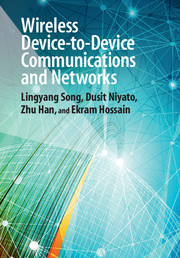Book contents
- Frontmatter
- Dedication
- Contents
- Preface
- Part I Introduction
- Part II Techniques for modeling and analysis of D2D communications
- Part III Resource management, cross-layer design, and security for D2D communications
- Part IV Applications of D2D communications
- Part V Standardization of D2D communications
- References
- Index
Preface
Published online by Cambridge University Press: 05 March 2015
- Frontmatter
- Dedication
- Contents
- Preface
- Part I Introduction
- Part II Techniques for modeling and analysis of D2D communications
- Part III Resource management, cross-layer design, and security for D2D communications
- Part IV Applications of D2D communications
- Part V Standardization of D2D communications
- References
- Index
Summary
Now that more and more new mobile multimedia-rich services are becoming available to mobile users, there is an ever-increasing demand for higher-data-rate wireless access. Therefore, new wireless technologies such as Long Term Evolution Advanced (LTEA) and WiMAX have been introduced, which are capable of providing high-speed, large-capacity, and guaranteed-quality-of-service (QoS) mobile services. Apart from the new technologies, new techniques such as small-cell networks and heterogeneous networks (HetNets) have also been developed, which are able to improve network capacity by reducing cell size and effectively controlling the interference. However, all these attempts still rely on a centralized network topology, which entails mobile devices communicating with a base station or access point. Such a centralized network topology is inherently limited by the capabilities of the base station and access point, which could be congested due to the presence of a large number of communicating devices. Also, the base station and access point might not have complete information about transmission parameters among devices, which is required in order to achieve the optimal network performance. To mitigate this problem, the concept of device-to-device (D2D) communications has been introduced to allow local peer-to-peer transmission among mobile devices offloading traffic from the base station and access point. Also, it is crucial to increase the wireless network capacity to accommodate the bandwidth-consuming mobile applications and services. Device-to-device communications is a promising concept to improve user experience and resource utilization in cellular networks, operating in both licensed and unlicensed spectrum bands.
The D2D communications can underlay or overlay a cellular network, using the same resources to improve the system throughput. Specifically, besides cellular operation, where user equipment (UE) is served by the network via the evolved NodeBs (eNBs) in the LTE architecture, UEs may communicate with each other directly over the D2D links. The UE in D2D connections still has to be loosely controlled by the eNBs in a network-controlled manner, thus continuing cellular operation.
- Type
- Chapter
- Information
- Wireless Device-to-Device Communications and Networks , pp. xv - xviiiPublisher: Cambridge University PressPrint publication year: 2015



